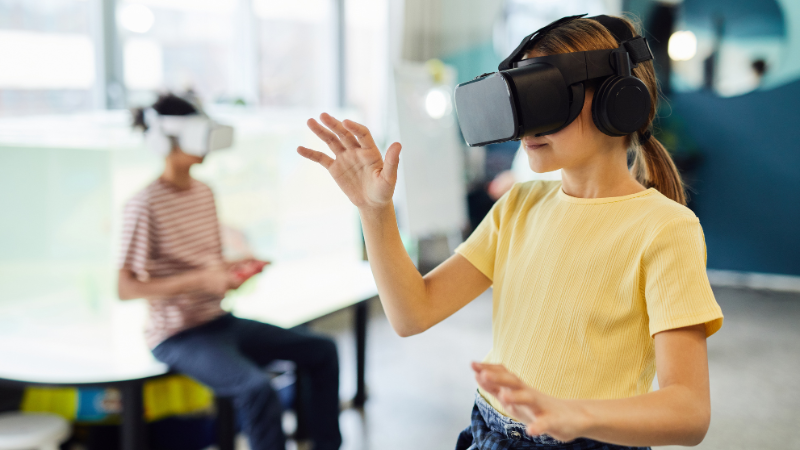In this article
ToggleVirtual reality is everywhere these days. The VR games market was valued at over USD$20 billion in 2022 and is expected to grow significantly more by 2030.
And that’s just games. More serious applications of VR include training:
- Australian soldiers for combat
- Retail staff to prepare for the madness of Black Friday sales
- Emergency personnel to respond to critical incidents
- Surgeons to perform transcatheter aortic valve replacements (heart surgery).
Why are governments and corporations investing so heavily in virtual reality as a training tool?
Because it works.
- Delivers immersive, responsive training that mimics stressful real-life situations
- Removes distractions – your entire focus is on the world within your headset
- Allows you to make mistakes without consequences – you can try, fail and try again without jeopardising your own or anyone else’s wellbeing
- Is multimodal and active, creating a whole-body experience that may help you retain what you’ve learned.
Virtual reality therapy (VRT)
When used under the guidance of a healthcare professional, virtual reality becomes a powerful therapy tool.
Virtual reality therapy for autism
Autism spectrum disorder (ASD) affects how a person thinks, communicates and interacts with the world. Navigating a world designed for and by neurotypical people is not easy for a person with autism. Supportive therapy often involves interventions to build skills and relieve anxiety or sensory overload.
In one small study, 20 autistic children aged 6-15 received 24 sessions of paediatric virtual reality therapy. Before the start of training and again at its conclusion, they undertook neurophysiological assessments and electroencephalogram (EEG) evaluations.
There was a significant difference in these before-and-after measurements. After their course of therapies, all patients showed improved attention processes and visuospatial cognition and their anxiety levels had reduced.
The EEG measurements were also interesting, demonstrating improved connectivity in the frontoparietal part of the brain. As we like to say at Neurofit, brain activity makes an active difference!
Virtual reality therapy for rehabilitation
VR enables people with Parkinson’s disease to experience physically challenging situations in a controlled environment. A systematic review and meta-analysis of 14 randomised controlled trials involving 524 participants concluded that VR-based rehabilitation significantly improved patients’ balance and confidence.
VR can also improve stroke patients’ upper and lower limb function. A systematic review and meta-analysis of 21 trials found that VR therapy improved stroke patients’:
- Muscle tension
- Muscle strength
- Range of motion
- Gait
- Balance
- Movements (kinematics).
For patients with traumatic brain injury, VR can help to detect visual-vestibular deficits (e.g. after concussion) and can help to improve attention span and executive function.
How Neurofit Brain Centre can help
At Neurofit, we’re strong believers in making therapy fun and engaging. One of our best tools is Neurosage, an immersive VR application designed for therapy.
We use Neurosage to support a range of patients – from neurodiverse conditions like autism and ADHD to neurodegenerative conditions like Parkinson’s disease.
If you’d like to explore virtual reality therapy, please book an assessment today.
Disclaimer
All information is general and is not intended to be a substitute for professional medical advice. Neurofit Brain Centre can consult with you to confirm if a particular therapy approach is right for you.
References
- The Washington Post, Virtual reality has expanded to a new field: job training, https://www.washingtonpost.com/technology/interactive/2023/virtual-reality-job-training/, [Accessed 22 August 2024]Brainline, Virtual reality exposure therapy, https://www.brainline.org/treatment-hub-treating-brain-injury-and-ptsd/virtual-reality-exposure-therapy-vret, [Accessed 22 August 2024]
- De Luca R, Naro A, Colucci PV, Pranio F, Tardiolo G, Billeri L, Le Cause M, De Domenico C, Portaro S, Rao G, Calabrò RS. Improvement of brain functional connectivity in autism spectrum disorder: an exploratory study on the potential use of virtual reality. J Neural Transm (Vienna). 2021 Mar;128(3):371-380. doi: 10.1007/s00702-021-02321-3. Epub 2021 Mar 6. PMID: 33677622. https://pubmed.ncbi.nlm.nih.gov/33677622/, [Accessed 22 August 2024]
- Kwon, SH., Park, J.K. & Koh, Y.H. A systematic review and meta-analysis on the effect of virtual reality-based rehabilitation for people with Parkinson’s disease. J NeuroEngineering Rehabil 20, 94 (2023). https://doi.org/10.1186/s12984-023-01219-3, [Accessed 22 August 2024]
- BioMed Research International, The Effects of Virtual Reality Training on Function in Chronic Stroke Patients: A Systematic Review and Meta-Analysis, https://onlinelibrary.wiley.com/doi/10.1155/2019/7595639, [Accessed 22 August 2024]
- Frontiers in Neurology, Virtual reality for traumatic brain injury, https://www.frontiersin.org/journals/neurology/articles/10.3389/fneur.2018.00345/full, [Accessed 22 August 2024]








